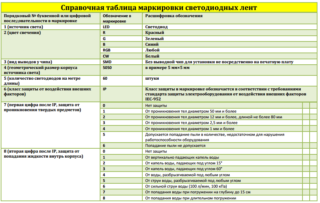LED strips are flexible strips with LEDs and an adhesive backing. They are used as a backlighting element or main lighting. PCB technology creates thin luminaires that fit easily in tight spaces. Their economical energy consumption and great design possibilities have made them the most popular lighting option.
- Scope of LED strip
- How does LED strip work?
- Backlight advantages and disadvantages
- Specifications
- Dimensions and density of installation of crystals
- Belt length and power
- Luminous flux and luminous efficiency
- Security class
- LED strip marking
- How to choose a quality backlight
- Types of LED strips
- Running fire ribbons
- How to keep backlighting for a long time
Scope of LED strip
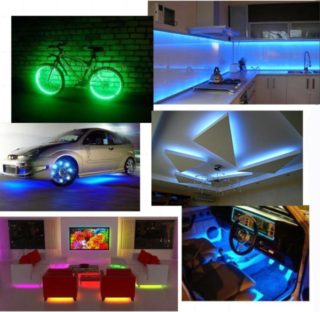
LED strips are indispensable for decorating ceiling structures, creating illumination of individual pieces of furniture and interior. LED lighting devices are used to decorate facades, cars, advertising banners and concert venues. Multicolor models create breathtaking compositions, creating the effect of running lights. Fountains and pools are decorated with sealed lamps.
How does LED strip work?
The light source is a printed circuit board located on the dielectric strip. The substrate differs in color, width, length. A common option is bays of 5 meters. The individual LEDs are connected with conductive paths, and there are resistors in the circuit.
The main part of the models operates on a constant voltage of 12, 24 or 36 V. Power is provided by special units that convert the mains voltage of 220 V. LED matrices consist of 1-3 crystals, they can be white or colored.
Backlight advantages and disadvantages
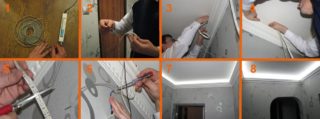
The main advantage of flexible ice luminaires is unlimited design possibilities in the decor of the premises. Also, the advantages of devices include:
- low power consumption;
- no need for system maintenance;
- high working resource (30-50 thousand hours);
- safety of use due to low voltage;
- availability of self-assembly;
- absence of harmful components in the design.
Disadvantages:
- The high cost of products. High-quality backlighting will cost 200-500 rubles per 1 meter.
- The need to replace old fittings.
- Most of the LEDs used give a CRI below 80, but for backlighting this is an acceptable figure.
- Brittle conductive tracks with repeated bending.
Specifications
When choosing a lighting fixture, buyers should be guided by its technical characteristics. In order for the tape to give a sufficient amount of light, take into account the power, size and number of diodes.
Dimensions and density of installation of crystals
The dimensions of the crystals are indicated in the product labeling. Popular types:
- 3528 - 3.5 x 2.8 mm, 1 die;
- 5050 - 5 × 5 mm, 3 crystals;
- 2835 - 2.8 × 35 mm.
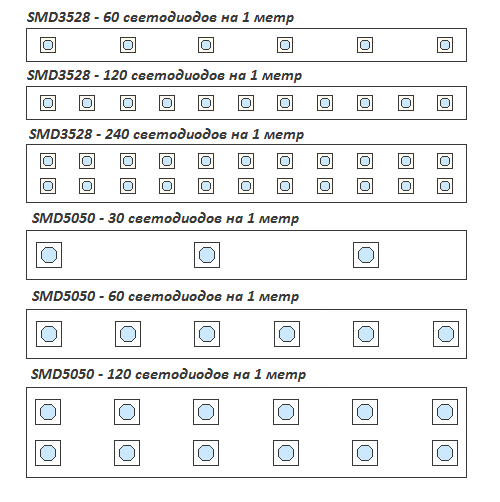
In addition to size, the brightness of the strip light depends on the number of diodes per meter. Power consumption is also related to the density of placement. Standard values: 30, 60, 90, 120 pieces. A denser installation is carried out in 2 rows, allowing 240 chips to be placed on 1 meter.
Belt length and power
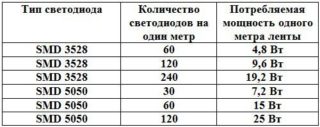
The power parameter is related to the size and density of the LEDs. Manufacturers indicate it for each model. Usually it is designed for a length of 1 meter, but some companies provide information on the entire length of the reel (5 m). Comparison example:
- 60 smd 3528 LEDs - 4.8 W / m;
- 60 smd 5050 LEDs - 15 W / m.
Thanks to its dimensions, the power has increased 3 times. The length of the product depends on the distance at which it will be installed. Standard lengths of 5 meters can be shortened or lengthened. The strips are cut along the marks. The connection is made by soldering. The total power of the lighting device is calculated by the formula: the specific power of 1 meter multiplied by the length. The power supply unit is selected with a margin of 20-30%.
Luminous flux and luminous efficiency
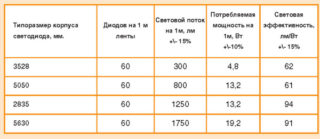
When choosing a backlight device, the exact amount of luminous flux is not calculated. Optical perception is sufficient. The main lighting is arranged according to the standards. In residential premises, 150 lm / m2 is required. A special table contains data for each type of LED, which determines the luminous flux of 1 meter of tape and its equivalent in incandescent lamps. Experts suggest taking devices with 120 or 240 diodes for lighting.
Security class
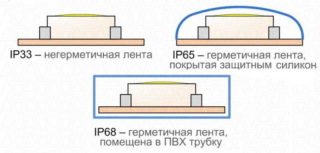
The scope of use of the lighting device depends on the degree of protection. The indicator determines the tightness of the LED strip. The class is indicated by the letters IP and two numbers. The first indicates the degree of protection against mechanical stress, the second - from moisture. The minimum parameter is IP20, the device is isolated from dirt particles, but does not tolerate moisture ingress. If the lighting will come into contact with water, it is advisable to take a product with a degree of at least 4.
Illumination class IP66-68 can be installed on facades, swimming pools and other reservoirs.
LED strip marking
- CW, R, B, G, RGB - glow color (white, red, blue, green, multicolor);
- diode size;
- density of LED strip per 1 meter;
- security class;
- RT, RTW - tape version (open, sealed);
- length;
- supply voltage.
Manufacturers can indicate the color of the base.
How to choose a quality backlight
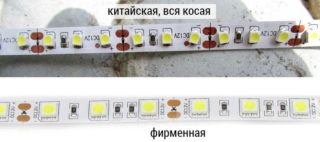
In order for the backlight to serve reliably and for a long time, you should take products from well-known companies Osram, Philips, Cree. When buying budget series, you will have to carefully consider the product. Main criteria:
- even arrangement of diodes;
- the same distance between the chips;
- uniform coverage;
- manufacturer's markings and logo;
- similar brightness of elements at different ends.
Choosing a high-quality LED is half the battle, you need to correctly install the lighting device.
Types of LED strips
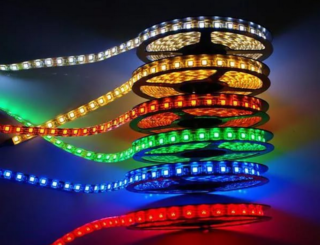
Depending on the characteristics, lighting devices are divided into several main groups.
By color:
- Monochrome or monochrome systems are a budget option for home lighting. They come in white or one of three colors - red, green, blue. For monochrome LED strips, it is enough to connect the power supply to the circuit. It is carried out with clamping terminals observing polarity. Monochromatic lighting is suitable for kitchen, nursery, stairs, wardrobes.
- Multicolor - RGB tapes are able to recreate the glow in different shades. To connect them, an adapter is not enough, a controller is required. Along the edges of the strips there are 4 wires, three of them for the controller, the fourth for the power supply. The device controls color change and luminous flux intensity. Facades, cars, shop windows are decorated with bright lamps.
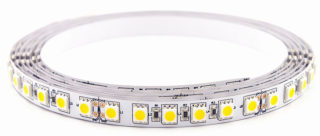
By execution:
- Open - they have a minimal degree of insulation, a thin layer of coating is applied to the body of the chips, which protects against dust. Moisture will damage the device.The products are recommended for hidden interior lighting.
- Sealed - printed circuit boards are covered with a layer of plastic or silicone. They are impervious to moisture and dirt particles. The security class indicates the reliability of the insulation of strip LEDs.

In the direction of the glow:
- Frontal - scattering angle 120 °, the light is directed perpendicular to the surface of the tape. This is the most common option.
- Side - scattering angle 90 °, diodes shine along the plane. Scope of application - advertising structures, interior details.
Running fire ribbons
Each LED in the strip drives its own controller. The devices are soldered into one chip. When choosing a controller for a system, it is necessary to take into account its compatibility with embedded microcircuits.
Devices with the "running fire" function are installed in entertainment establishments to decorate the landscape.
How to keep backlighting for a long time
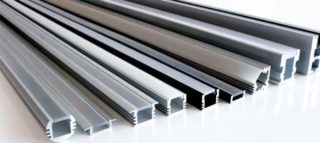
The resource of ice tape backlighting from well-known manufacturers is 30-50 thousand hours. To prevent the degradation of crystals prematurely, it is necessary to exclude overheating of the elements. The maximum temperature is 40 ° C. It can be exceeded with continuous load, the device is located near a heat source. It is not recommended to use sealed tapes without a cooling system. The destruction of crystals leads to a loss of brightness.
Installation on an aluminum profile allows to prevent the negative effects of heating. It promotes heat dissipation. A matte or transparent screen is purchased for the profile.
An additional criterion for the selection of backlighting is the color of the base. The substrate can be white, black, brown. It must match the surface on which it is mounted. The quality of the adhesive layer is important. It adheres best to horizontal surfaces. In some cases, additional fastening is required.

